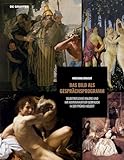Das Bild als Gesprächsprogramm : Selbstreflexive Malerei und ihr kommunikativer Gebrauch in der Frühen Neuzeit / Wolfgang Brassat.
Material type: TextPublisher: Berlin ; Boston : De Gruyter, [2021]Copyright date: ©2021Description: 1 online resource (448 p.)Content type:
TextPublisher: Berlin ; Boston : De Gruyter, [2021]Copyright date: ©2021Description: 1 online resource (448 p.)Content type: - 9783110726176
- 9783110726008
- online - DeGruyter
- Issued also in print.
| Item type | Current library | Call number | URL | Status | Notes | Barcode | |
|---|---|---|---|---|---|---|---|
 eBook
eBook
|
Biblioteca "Angelicum" Pont. Univ. S.Tommaso d'Aquino Nuvola online | online - DeGruyter (Browse shelf(Opens below)) | Online access | Not for loan (Accesso limitato) | Accesso per gli utenti autorizzati / Access for authorized users | (dgr)9783110726008 |
Frontmatter -- INHALTSVERZEICHNIS -- EINLEITUNG -- KAPITEL I FRA ANGELICOS PALA DI SAN MARCO : BEOBACHTUNG ZWEITER ORDNUNG UND DIE ANFÄNGE DES INDIVIDUALSTILS -- KAPITEL II PROGRAMME FÜR ZAHLLOSE KOMMUNIKATIONEN: DIE PRIMAVERA UND WEITERE WERKE BOTTICELLIS -- KAPITEL III PENDANTS UND KONKURRENZWERKE: DIALOGIZITÄT UND INTERPIKTURALITÄT IN WERKEN RAFFAELS -- KAPITEL IV DIE PRAXIS DER GESELLIGEN REZEPTION UND DIE SELBSTREFLEXIVE, IRONISCHE, ENIGMATISCHE UND HERMETISCHE KUNST DES CINQUECENTO -- KAPITEL V ANNIBALE – CARAVAGGIO – DOMENICHINO -- KAPITEL VI ZUR MALEREI DER RUBENS-ZEIT -- KAPITEL VII DEUTUNGSPLURALISMUS UND STAATSRÄSON. DIE NIEDERLANDE UND FRANKREICH IM SPÄTEN 17. JAHRHUNDERT -- KAPITEL VIII DER HÖHEPUNKT UND AUSKLANG DER EPOCHE DER KONVERSATION -- VERZEICHNIS DER ABGEKÜRZT ZITIERTEN LITERATUR -- REGISTER -- ABBILDUNGSNACHWEIS -- DANK
restricted access online access with authorization star
http://purl.org/coar/access_right/c_16ec
Die vorliegende Publikation befasst sich mit der Malerei der Frühen Neuzeit unter dem Aspekt ihres kommunikativen Gebrauchs. Im Unterschied zur Moderne herrschte in der Frühneuzeit das Ideal einer geselligen spielerischen Kunstrezeption, bei der die Werke in und durch konversationsrhetorische Sprachkunst übersetzt und kommentiert wurden. Mit Blick auf fortschreitende Autonomisierungsprozesse untersucht Wolfgang Brassat an ausgewählten Beispielen vom Quattrocento bis zur französischen und englischen Kunst des 18. Jahrhunderts, wie Künstler z.B. durch rekursive und selbstreflexive Verfahren, rätselhafte und mehrdeutige Bildelemente, das Durchkreuzen etablierter Darstellungskonventionen und Infragestellen des tradierten Kunstbegriffs das Gespräch über ihr Werk und die Künste anregten.
The present publication deals with the communicative use of painting during the early modern period. In contrast to modernism, the early modern period was characterized by the ideal of a sociable, playful reception of art, in which works were translated and commented on in and through conversational rhetorical language. With a view to progressive processes of art becoming autonomous, Wolfgang Brassat uses selected examples from the quattrocento to French and English art of the 18th century to investigate how artists stimulated conversation about their work and the arts through recursive and selfreflexive procedures, enigmatic and ambiguous pictorial elements, the thwarting of established representational conventions, and the questioning of the traditional concept of art.
Issued also in print.
Mode of access: Internet via World Wide Web.
In German.
Description based on online resource; title from PDF title page (publisher's Web site, viewed 01. Dez 2022)


